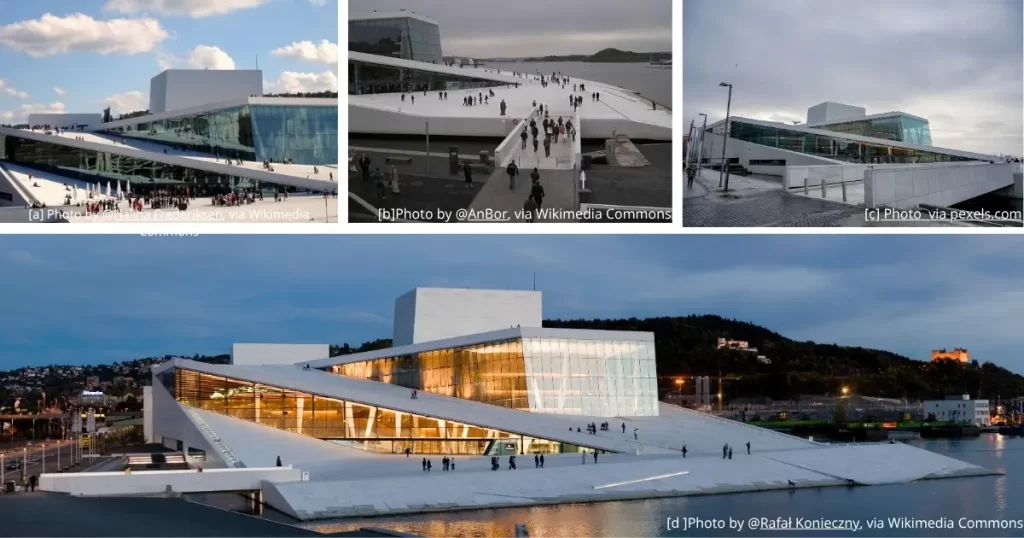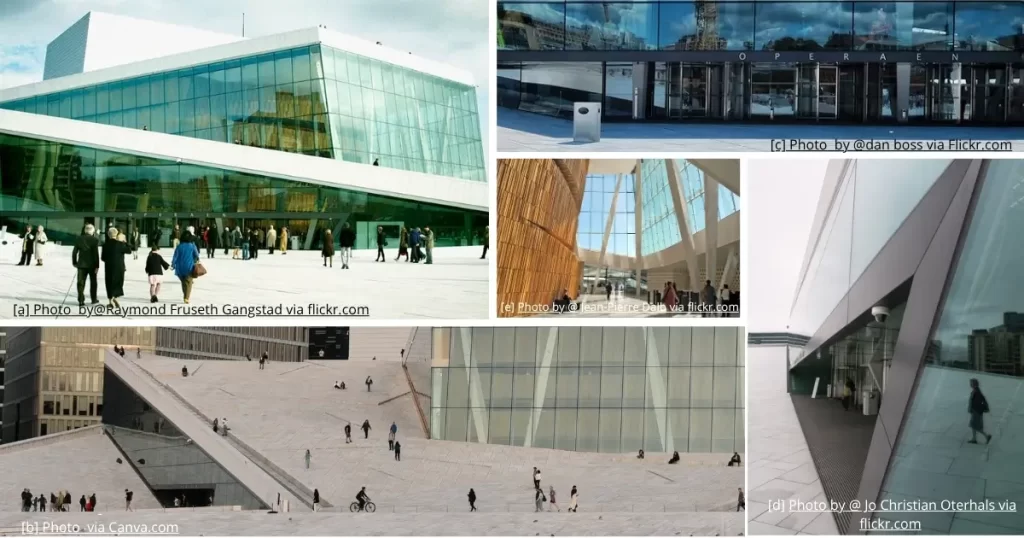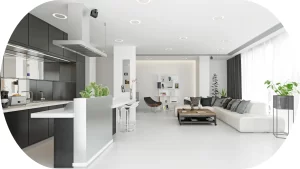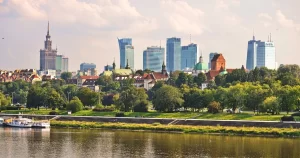Oslo Opera House: How to Explore Norway’s Masterpiece of Eco-Design Innovation
By Mz Chaker & EAGC │July 29, 2025
Explore how the Oslo Opera House gem blends Architecture, Nature, and Sustainability in the heart of one of Europe’s greenest capitals.

Introduction: Unveiling Oslo’s Iconic Waterfront Gem
Imagine standing on a building that rises straight from the fjord. Sleek, Sculptured, and snow-white, it invites you to walk up its wide marble roof as the sea sparkles below. It isn’t a dream. It’s the Oslo Opera House—a bold place where modern architecture, nature, and public life blend perfectly.
Sitting on Oslo’s transformed Bjørvika waterfront, the Oslo Opera House is more than a performance venue. It’s the national home for opera and ballet. But also it’s a symbol of Norway’s creative and forward-thinking spirit.
In this article, we’ll take you on a complete journey through this architectural marvel, from its award-winning design and sustainable features to performance highlights and travel tips. Whether you’re an architecture lover, a cultural traveler, or just curious, this guide reveals why the Oslo Opera House is an unmissable stop in one of the Best Cities in Europe to visit.
Oslo has long been renowned for its clean, modern, and nature-loving image. Its fresh air, scenic charm, and Green City planning make it unique. The Oslo Opera House is the jewel in its crown—open, welcoming, and built for everyone.
1. A Marvel of Modern Architecture: The Design Philosophy of Snøhetta
Behind the bold white angles of the Oslo Opera House stands Snøhetta, the award-winning Norwegian architecture firm renowned for seamlessly merging nature and culture through its design. Their global works include the Alexandria Library in Egypt. They also led the expansion of the San Francisco Museum of Modern Art.
But in 2008, they made headlines at home. That year, they delivered a masterpiece that changed Oslo’s identity forever. More than just a venue for performance, the Opera House became something bigger. It anchored the transformation of the Bjørvika district. Once an industrial port, the area evolved into a vibrant urban landscape of green buildings and rich cultural life.
The “Emerging from Water” Concept
From afar, the building appears to rise out of the fjord like an iceberg or glacial slope. However, the accurate design idea centered on thresholds—the transitions between water, land, public, and private spaces. The roof’s gentle slope blurs the boundary between the building and the plaza. Visitors don’t just look at it; they walk on it, rest, take in the view, and participate in it.
The building plays with movement and light:
- To begin with, a long pedestrian bridge slows your pace as you approach.
- Then, the open roof unfolds as a gathering space and visual connector.
- Finally, you step through a modest doorway from the main entrance into a stunning, high-ceilinged foyer bathed in natural light.
This choreography reflects the building’s deeper role as a passageway between city and fjord, between solitude and spectacle.

Oslo Opera House- Freedom to Roam in the Urban Landscape: [a] Photo by @Halina Frederiksen, via Wikimedia Commons; [b]Photo by @AnBor, via Wikimedia Commons; [d ]Photo by @Rafał Konieczny, via Wikimedia Commons
Artistic Materials, Musical Spirit
Materials matter here. The façade features dazzling white Italian marble and polished glass, which glow differently as the light shifts through the day. Notably, the roof’s marble was chosen for its musical resonance. It even produces a soft ringing sound underfoot—a poetic nod to the building’s purpose.
But it’s not just about materials—it’s about art and emotion, too. Inside and out, artists played a crucial role in shaping the experience:
- First, sculpted aluminum cladding by Løvaas & Wagle creates playful concave patterns across the surfaces.
- Then, the marble roof features abstract etchings by Blystad, Grude, and Sannes, evoking the image of ice and flowing waves.
- Finally, even the restrooms are elevated by design: Olafur Eliasson’s perforated cladding turns a functional space into a shimmering visual delight.
What Makes Oslo Opera House a Landmark of Sustainable Architecture
Beyond aesthetics, the Oslo Opera House is a model of eco-conscious design:
- Rooftop Walkability: The gently sloping roof isn’t just an architectural flourish. It acts like a public park—open, accessible, and barrier-free. People walk, sit, take photos, or enjoy impromptu gatherings. It’s an open invitation to engage with the building informally, day or night.
- Passive Design Strategies: The building’s layout and form aren’t just beautiful. They’re also smart. The orientation takes advantage of solar heat gain in winter while minimizing glare. Thick concrete walls provide thermal mass, helping to regulate interior temperatures naturally. Cross-ventilation from well-placed openings reduces the need for artificial cooling.
- Daylight Optimization: Expansive glass facades let natural light flood deep into the interiors, dramatically reducing daytime electricity usage. It also enhances the visitor experience, making the spaces feel bright, open, and connected to the outdoors.
- Green Materials: Materials were carefully selected with the environment in mind. Local Norwegian oak, natural stone, and low-emission finishes minimize the building’s overall environmental impact. By sourcing regionally, the team minimized carbon emissions from transport while supporting local industries.
- Energy Performance: A sophisticated system pumps seawater from the fjord to cool the building. Combined with efficient HVAC and lighting systems, this strategy helps reduce operational energy costs. These innovations helped the building earn a BREEAM “Excellent” rating—a high bar in sustainable design for civic spaces.
Unsurprisingly, the building received the European Union Prize for Contemporary Architecture—Mies van der Rohe Award in 2009, among many other awards.

Oslo Opera House interior: [d] Photo by @Jean-Pierre Dalbéra, via Wikimedia Commons; [e] Photo by @Jean-Pierre Dalbéra, via Wikimedia Commons; [f] Photo by @Jean-Pierre Dalbéra, via flickr.com

Oslo Opera House – The main Enrance :[a] Photo by@Raymond Fruseth Gangstad via flickr.com; [c] Photo by @dan boss via Flickr.com; [d] Photo by @ Jo Christian Oterhals via flickr.com; [e] Photo by @ Jean-Pierre Dalb, via flickr.com
2. The Iconic Roof Walk: Freedom to Roam in the Urban Landscape
So, can you walk on the roof? Absolutely. You’re invited to. Few cultural buildings in the world offer this kind of freedom—and none in such a dramatic setting. The design embodies “allemannsretten”, Norway’s “right to roam.” This centuries-old tradition allows the public to explore nature freely and respectfully. Here, that idea is reimagined for the city: the roof is a landscape, open to all, day or night.
A 360° Panoramic Canvas
Step onto the slope and Oslo opens before you. Each glance offers a new layer of the city’s beauty:
- First, the blue waters of the Oslofjord stretch endlessly, mirroring the sky in all its moods.
- Then, sleek towers of the Barcode District rise like jagged sheet music, forming Oslo’s new architectural skyline.
- Nearby, the Munch Museum becomes visible. Its crisp lines and reflective glass pay tribute to Nordic modernism and deep creativity.
- In the distance, snowy hills shimmer in winter, while golden sunsets bathe the skyline in warm, amber hues in summer.
Whether you’re snapping photos, sipping coffee, or just taking a quiet moment to breathe, this rooftop offers something rare. It feels like being on top of the world, where nature and city blend into one unforgettable view.
More Than a Viewpoint
The roof also hosts seasonal outdoor events that bring the structure to life in new ways. From impromptu jazz sessions to fully staged dance performances, its sloping marble surface becomes a stage unlike any other. Artists, students, and cultural organizations all take turns transforming the rooftop into an open-air theater.
Whether it’s a sunrise yoga class or a summer opera snippet under the stars, these events invite everyone to engage. It’s not just a green city backdrop—it’s a living, breathing platform for creativity, expression, and shared community energy.
3. A Hub of World-Class Culture & Performance
While the roof stuns visitors, the heart of the building beats inside. The Oslo Opera House is the home of the Norwegian National Opera and Ballet, two of Scandinavia’s most respected cultural institutions. More than 600 professionals, from costume makers to choreographers, bring the space alive with music, movement, and emotion every day.
A Stage for All Art Forms
The performance schedule at the Oslo Opera House offers something for everyone, from first-time visitors to seasoned opera lovers. Audiences can enjoy:
- Classic masterpieces like “La Bohème” or “Swan Lake” continue to stir emotions with their timeless stories and music.
- For those seeking innovation, contemporary reinterpretations surprise and delight with bold staging, multimedia art, and experimental direction.
- The venue regularly hosts visiting stars and international co-productions, drawing global attention and fostering creative exchange across borders.
One standout example was the 2016 production of La Traviata. In this performance, swirling video projections transformed the stage. These visuals added a haunting new layer of emotion to Verdi’s classic, making it feel fresh and profoundly moving.
The Main Hall: Craft Meets Craftsmanship
As you step into the core of the opera experience, every detail of the main hall begins to unfold with purpose. This space has been crafted to inspire and impress, from the seats to the lighting and acoustics. Let’s take a closer look:
- 1,350 seats, all crafted in glowing golden oak, warm the audience and offer clear sightlines from every angle. Their ergonomic design ensures comfort while enhancing acoustic delivery for all.
- Above them, a spectacular chandelier of 8,000 handblown lamps floats like frozen starlight. The fixture doubles as artwork and lighting, casting a soft, golden shimmer across the hall.
- Along the walls, the oak-paneled “wave wall” serves a dual purpose. It reflects sound with precision while mimicking the gentle ebb of the nearby sea.
- Beneath your feet, the performance hall is partly submerged below sea level. This submerged design buffers sound and vibration, optimizing resonance and audience immersion.
- Framing the stage, the curtain, designed by artist Pae White, adds a bold visual touch. Its silk-printed image of crumpled aluminum foil creates a textured effect, suggesting fluidity and motion.
Even the smallest corners echo intention and craft. From Eliasson’s geometric metalwork that catches light near the stairwells to the handrails carved to fit your palm, every detail is made to be felt as much as seen.

Oslo Opera House – The main Hall : [a] Photo by@Hans A. Rosbach, via Wikimedia Commons; [b ]Photo by @Kjetil Ree, via Wikimedia Commons; [c] Photo by@Hans A. Rosbach, via Wikimedia Commons
4. Planning Your Visit: Essential Information & FAQs
Planning a visit to the Oslo Opera House? Before you go, here’s everything you need to know—from how to get there and what to wear to ticket info, dining options, and accessibility services.
Getting There
Located in the Bjørvika district, the Opera House is an easy 10-minute walk from Oslo Central Station. It’s right beside the Munch Museum and overlooks the fjord, making it part of a perfect day of eco-tourism.
Is It Free to Visit?
Yes—the roof and lobby are free to explore, making this one of the city’s top sustainability-focused public spaces. For deeper exploration:
- Guided tours (approx. 120–150 NOK) offer backstage access, costume rooms, and architecture insights.
- Show tickets range from 100 to 800 NOK, depending on the seat and performance.
Accessibility
The Opera House is fully accessible:
- Elevators and ramps throughout
- Dedicated wheelchair seating
- Helpful staff trained in assistance
Gift Shops & Photography
The boutique offers:
- Books on architecture and Norwegian culture
- Handcrafted souvenirs
- Music and performance-themed gifts
Photography is permitted on the roof and in the lobby but not during shows.
What to Wear
There’s no strict dress code. Come as you are:
- Casual? Jeans and a sweater work.
- Dressy? Perfect for a night out.
Locals mix style with comfort. Be yourself.
Dining Options
There are two on-site dining spots:
- Sanguine Brasserie for elegant meals before the show.
- Argent Restaurant for refined Nordic cuisine.
Enjoy drinks on the terrace while watching the sunset.

Oslo Opera House Outdoor Restaurants : [a] Photo by @Jean-Pierre Dalbéra, via flickr.com; [b] Photo by @Jean-Pierre Dalbéra, via flickr.com; [c] Photo by @JHelge Høifødt, via Wikimedia Commons
Booking Tickets
You can book online via the Oslo Opera House’s official website or in person at the box office. Tickets often sell fast, especially for ballets and premieres, so book early.
5. Unforgettable Oslo Opera House Experience
Every iconic place leaves an emotional imprint—and here, it begins the moment you arrive. What makes this place unforgettable isn’t just its design—it’s the way it makes people feel again and again. There’s a reason people come back. Some say standing on the marble at dusk, with the fjord in front and city lights behind, is like falling in love with Oslo itself.
From the moment you step onto the rooftop, all your senses awaken—the sounds: seagulls overhead, soft music drifting from inside. The textures follow—cool marble underfoot grounds your steps, while warm wood inside offers a welcoming contrast. And then, the feeling takes over: calm, curious, and deeply connected to the world around you.
Each weather shift paints a different picture. Rainy days bring moody reflections that ripple across the marble. Snow turns the roof into a quiet white wonderland, muffling sounds and adding soft magic. At night, the glowing interior comes alive, making the building pulse like a lantern by the sea.
Every visit feels different, yet always serene and inspiring. That’s the beauty of the Opera House: it shifts with time, weather, and mood, inviting you into a unique moment each time you return.
Conclusion: Don’t Miss This Oslo Gem
When one place manages to combine culture, beauty, and sustainability so effortlessly, it’s bound to leave a mark. At the heart of it all, the Oslo Opera House offers visitors a rare blend of experiences that speak to the soul and the senses. It stands as a globally acclaimed architectural icon. At the same time, it’s a vibrant home for rich, evolving modern architecture and performance.
Even more, it features a walkable roofscape open to all, fully embracing Green Cities values. And just as importantly, it shines as a leading example of Sustainable Architecture that genuinely welcomes everyone.
So go ahead—walk the roof, take in the views, step inside for a show, or sit and breathe in the Nordic calm. Whether you’re seeking art, architecture, or just inspiration, this is one of those rare places that truly delivers something for everyone.
If you’re ready to explore even more of Oslo’s creative energy, consider pairing your Opera House visit with a walk through the Munch Museum, steps away. Or take a peaceful stroll to the historic Akershus Fortress overlooking the harbor. Then, enjoy a memorable meal at one of the many restaurants along the Aker Brygge waterfront promenade. And if you crave something eclectic and edgy, wander through the colorful streets of Grünerløkka, Oslo’s creative heart.
Leave a Comment




